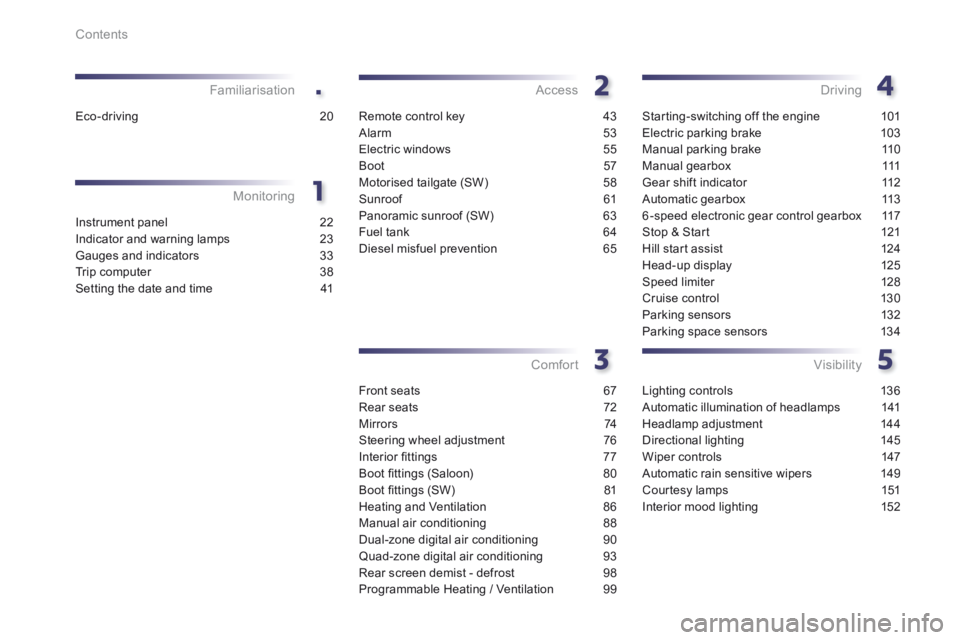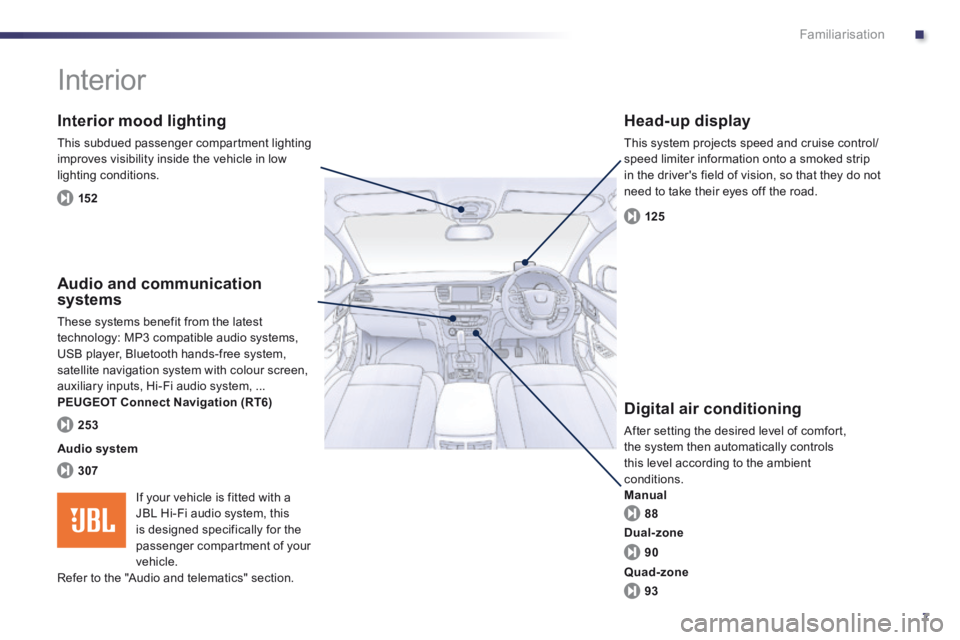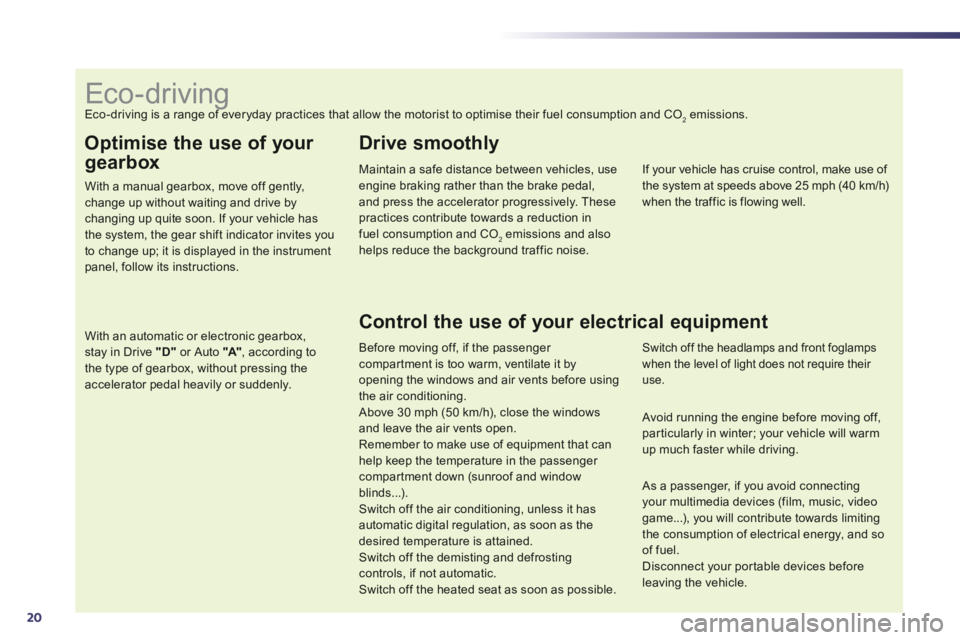Page 4 of 352

.
Contents
Instrument panel 22
Indicator and warning lamps 23
Gauges and indicators 33
Trip computer 38
Setting the date and time 41
Monitoring
Familiarisation
Remote control key
43
Alarm 53
Electric windows 55
Boot 57
Motorised tailgate (SW) 58
Sunroof 61
Panoramic sunroof (SW) 63
Fuel tank 64
Diesel misfuel prevention 65
Access
Front seats 67
Rear seats 72
M i r r o r s 74
Steering wheel adjustment 76
Interior fi ttings 77
Boot fi ttings (Saloon) 80
Boot fi ttings (SW) 81
Heating and Ventilation 86
Manual air conditioning 88
Dual-zone digital air conditioning 90
Quad-zone digital air conditioning 93
Rear screen demist - defrost 98
Programmable Heating / Ventilation 99
Comfort
Starting-switching off the engine 101
Electric parking brake 103
Manual parking brake 110
Manual gearbox 111
Gear shift indicator 112
Automatic gearbox 113
6-speed electronic gear control gearbox 117
Stop & Start 121
Hill start assist 124
Head-up display 125
Speed limiter 128
Cruise control 130
Parking sensors 132
Parking space sensors 134
Driving
Lighting controls 136
Automatic illumination of headlamps 141
Headlamp adjustment 144
Directional lighting 145
Wiper controls 147
Automatic rain sensitive wipers 149
Courtesy lamps 151
Interior mood lighting 152
Visibility
Eco-driving 20
Page 9 of 352

.
7
Familiarisation
Interior
Interior mood lighting
This subdued passenger compartment lighting improves visibility inside the vehicle in low lighting conditions.
Head-up display
This system projects speed and cruise control/speed limiter information onto a smoked strip in the driver's field of vision, so that they do not need to take their eyes off the road.
Digital air conditioning
After setting the desired level of comfort, the system then automatically controls this level according to the ambient conditions. Manual
Audio and communication systems
These systems benefit from the latest technology: MP3 compatible audio systems, USB player, Bluetooth hands-free system, satellite navigation system with colour screen, auxiliary inputs, Hi-Fi audio system, ... PEUGEOT Connect Navigation (RT6)
152
125
88
307
253
Audio system
90
93
Dual-zone
Quad-zone
If your vehicle is fitted with a JBL Hi-Fi audio system, this is designed specifically for the
passenger compartment of your vehicle. Refer to the "Audio and telematics" section.
Page 12 of 352
10Familiarisation
9. Fusebox. 10. Front door window demisting/defrosting vent. 11. Windscreen demisting/defrosting vent. 12 . Steering lock and starting with the key. 13. Starting using the electronic key. 14 . Audio equipment steering wheel controls. 15. Wiper / screenwash / trip computer stalk. 16. Central locking and hazard warning buttons. 17. Multifunction screen.
Instruments and controls
1. Cruise control / speed limiter controls. 2. Headlamp height adjustment. 3. Lighting and direction indicator stalk 4. Instrument panel. 5. Driver's airbag. Horn. 6. Gear lever. 7. 12 V accessory socket USB port / auxiliary socket. 8. Bonnet release lever.
18. Central adjustable air vents. 19. Passenger's airbag. 20. Side adjustable air vents. 21. Glove box / Passenger's airbag deactivation. 22. Electric parking brake. 23. Central armrest with storage. 24. Storage (according to version). 25. Audio system. 26. Heating / air conditioning controls.
Page 21 of 352
.
19
Familiarisation
Driving safely
1. Selecting speed limiter mode. 2. Decrease the programmed value. 3. Increase the programmed value. 4. Pause/resume speed limiter. 5. Speed limiter off.
Speed limiter "LIMIT"
128
1. Selecting cruise control mode. 2. Decrease the programmed value. 3. Increase the programmed value. 4. Pause/resume cruise control. 5. Cruise control Off.
Cruise control "CRUISE"
130
The cruise control or speed limiter mode appears in the instrument panel when it is selected.
Display in the instrument panel
Cruise control
Speed limiter
The values must be set with the engine running. In order to be programmed or activated, the vehicle speed must be higher than 25 mph (40 km/h), with at least 4th gear engaged on a manual gearbox (2nd gear on an electronic gear control or automatic gearbox).
Page 22 of 352

20
Optimise the use of your
gearbox
With a manual gearbox, move off gently, change up without waiting and drive by changing up quite soon. If your vehicle has
the system, the gear shift indicator invites you to change up; it is displayed in the instrument panel, follow its instructions.
With an automatic or electronic gearbox, stay in Drive "D" or Auto "A" , according to the type of gearbox, without pressing the accelerator pedal heavily or suddenly.
Drive smoothly
Maintain a safe distance between vehicles, use engine braking rather than the brake pedal, and press the accelerator progressively. These practices contribute towards a reduction in
fuel consumption and CO2 emissions and also helps reduce the background traffic noise.
If your vehicle has cruise control, make use of the system at speeds above 25 mph (40 km/h) when the traffic is flowing well.
Control the use of your electrical equipment
Before moving off, if the passenger compartment is too warm, ventilate it by opening the windows and air vents before using the air conditioning. Above 30 mph (50 km/h), close the windows and leave the air vents open.
Remember to make use of equipment that can help keep the temperature in the passenger compartment down (sunroof and window blinds...). Switch off the air conditioning, unless it has automatic digital regulation, as soon as the desired temperature is attained. Switch off the demisting and defrosting controls, if not automatic. Switch off the heated seat as soon as possible.
Switch off the headlamps and front foglamps when the level of light does not require their use.
Avoid running the engine before moving off, particularly in winter; your vehicle will warm up much faster while driving.
As a passenger, if you avoid connecting your multimedia devices (film, music, video game...), you will contribute towards limiting the consumption of electrical energy, and so of fuel. Disconnect your portable devices before leaving the vehicle.
Eco-driving Eco-driving is a range of everyday practices that allow the motorist to optimise their fuel consumption and CO2 emissions.
Page 24 of 352
22
Monitoring
Petrol-Diesel instrument panel
1. Rev counter (x 1 000 tr/min or rpm), graduation according to engine (petrol or Diesel). 2. Engine oil temperature gauge. 3. Fuel gauge. 4. Engine coolant temperature gauge. 5. Speedometer (mph or km/h). 6. Cruise control or speed limiter settings.
7. Gear shift indicator for a manual gearbox or gear lever position and gear for an electronic gear control or automatic gearbox.
A. Main lighting dimmer. B. Display of alert log. Recall of the service information. C. Reset the trip distance recorder.
8. Display zone: alert messages or state of functions, trip computer. 9. Trip distance recorder (miles or km). 10. Automatic wipers Service indicator (miles or km) then, total distance recorder. These two functions are displayed
successively when switching on the ignition.
Dials and screens Control buttons
Page 80 of 352
78
Comfort
Mats Removable carpet protection.
When fitting the mat for the first time, on the driver's side use only the fixings provided in the wallet attached. The other mats are simply placed on the carpet.
Fitting
Removal
To remove the mat on the driver's side: move the seat as far back as possible, unclip the fixings, remove the mat.
Refitting
To refit the mat on the driver's side: position the mat correctly, refit the fixings by pressing, check that the mat is secured correctly.
To avoid any risk of jamming of the pedals: - only use mats which are suited to the fixings already present in the vehicle; these fixings must be used, - never fit one mat on top of another. The use of mats not approved by PEUGEOT may inter fere with access to the pedals and hinder the operation of
the cruise control / speed limiter.
Lower the rear armrest for a more comfortable position. It may be fitted with cup holders and also gives access to the ski flap.
Rear armrest
Page 127 of 352
4
125
Driving
Head-up display
System which projects various information onto a smoked strip in the field of vision of the driver so that they do not have to take their eyes off the road.
1. Head-up display on. 2. Head-up display off (long press). 3. Brightness adjustment. 4. Display height adjustment.
Buttons
Once the system has been activated, the following information is grouped together in the head-up display: A. The speed of your vehicle. B. Cruise control/speed limiter information.
Displays during operation
C. Navigation information (according to ve r s i o n).
For more information on the navigation system, refer to the "Audio and telematic" section.
This system operates when the engine is running and the settings are stored when the ignition is switched off.